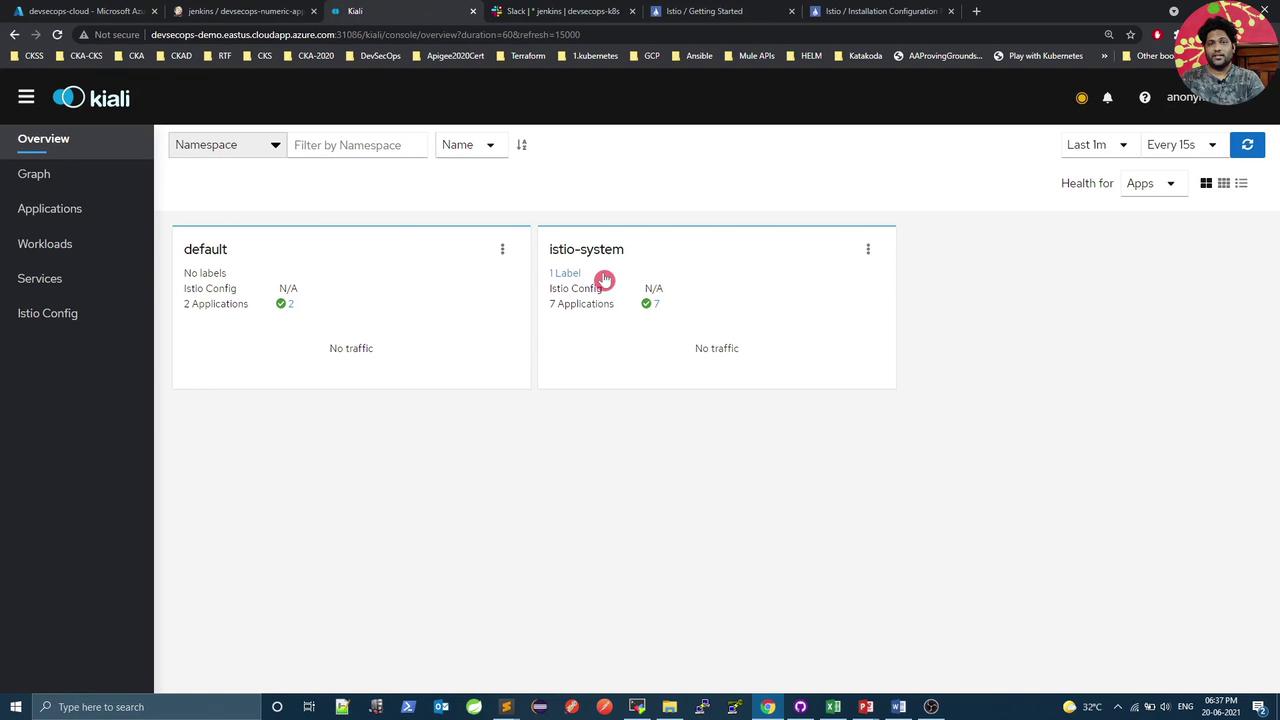DevSecOps - Kubernetes DevOps & Security
Kubernetes Operations and Security
Demo Istio Installation
Learn how to download, install, and verify Istio 1.9.0 on a Kubernetes cluster using the demo profile. You’ll also explore built-in add-ons like Kiali, Prometheus, Grafana, and Jaeger for full observability.
Prerequisites
- A running Kubernetes cluster (version compatible with Istio 1.9.0)
kubectlconfigured to interact with your cluster
Step 1: Download and Install Istio
1.1 Download Istio 1.9.0
Fetch the installer script and extract the release:
curl -Ls https://istio.io/downloadIstio | ISTIO_VERSION=1.9.0 sh -
cd istio-1.9.0
export PATH=$PWD/bin:$PATH
1.2 Install the Demo Profile
Note
The demo profile is preconfigured with observability add-ons for testing and learning. It is not recommended for production environments.
Install Istio’s control plane and sample add-ons:
istioctl install --set profile=demo -y
kubectl apply -f samples/addons
1.3 Verify Installation Output
After installation, you should see messages similar to:
namespace "istio-system" created
configmap "istio-sidecar-injector" created
customresourcedefinition "virtualservices.networking.istio.io" configured
customresourcedefinition "destinationrules.networking.istio.io" configured
deployment "grafana" created
deployment "kiali" created
service "grafana" created
service "kiali" created
Step 2: Istio Components Overview
Once installed, Istio deploys core control-plane components and add-ons. Here’s what you get:
| Component | Purpose |
|---|---|
Namespace istio-system | Isolates the service mesh control plane |
ConfigMap istio-sidecar-injector | Automates Envoy sidecar injection |
CRDs (VirtualService, DestinationRule) | Define traffic management policies |
Control Plane (istiod, gateways) | Manages configuration and proxies |
| Jaeger | Distributed tracing |
| Prometheus | Metrics collection and alerting |
| Grafana | Visualize time-series data |
| Kiali | Service mesh observability and topology maps |

Step 3: Verify the Control Plane and Add-ons
3.1 List All Istio Resources
Run:
kubectl -n istio-system get all
Expected output:
NAME READY STATUS RESTARTS AGE
pod/istiod-xxxxxx-xxxxx 1/1 Running 0 1m
pod/istio-ingressgateway-xxxxx-xxxxx 1/1 Running 0 1m
pod/istio-egressgateway-xxxxx-xxxxx 1/1 Running 0 1m
pod/prometheus-xxxxx-xxxxx 1/2 Running 0 1m
pod/grafana-xxxxx-xxxxx 1/1 Running 0 1m
pod/jaeger-xxxxx-xxxxx 1/1 Running 0 1m
pod/kiali-xxxxx-xxxxx 1/1 Running 0 1m
NAME TYPE CLUSTER-IP EXTERNAL-IP PORT(S)
service/istiod ClusterIP 10.0.0.123 <none> 15012/TCP,443/TCP
service/istio-ingressgateway LoadBalancer 10.0.0.124 <pending> 80:31500/TCP,443:31501/TCP
service/prometheus ClusterIP 10.0.0.125 <none> 9090/TCP
service/grafana ClusterIP 10.0.0.126 <none> 3000/TCP
service/jaeger-collector ClusterIP 10.0.0.127 <none> 14250/TCP,14268/TCP
service/kiali ClusterIP 10.0.0.128 <none> 20001/TCP
Step 4: Enable Automatic Sidecar Injection
Label your application namespace to inject Envoy sidecars automatically:
kubectl label namespace default istio-injection=enabled
Warning
Enabling sidecar injection will add an Envoy proxy to every pod in the default namespace. Ensure your workloads are compatible.
Step 5: Access the Kiali Dashboard
By default, Kiali’s service is ClusterIP. To expose it on a NodePort:
5.1 Change Service Type
kubectl edit service kiali -n istio-system
In the editor, update:
spec:
type: NodePort
Save and exit.
5.2 Retrieve and Use the NodePort
kubectl get service kiali -n istio-system
Sample output:
NAME TYPE CLUSTER-IP EXTERNAL-IP PORT(S) AGE
kiali NodePort 10.0.0.128 <none> 20001:32001/TCP,9090:32002/TCP 2m
Point your browser to:
http://<NODE_IP>:32001
to open the Kiali UI.

Links and References
- Istio Documentation
- Kubernetes Basics
- Kiali Project
- Prometheus Documentation
- Grafana Documentation
- Jaeger Documentation
Watch Video
Watch video content